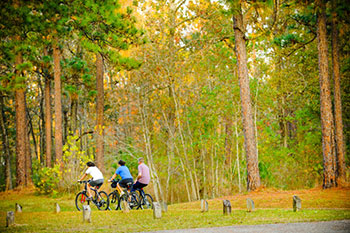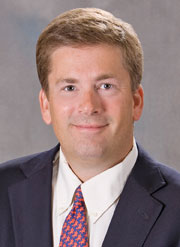Afew years ago, folks in Southwest Louisiana talked about the long road toward economic recovery following devastating hurricanes, an historic oil spill and a global financial crisis that would severely test the mettle of an entire region.
Today, leaders in other parts of the U.S. look at the record-setting economic development in Southwest Louisiana and ask, “How can we make that happen in our community?”
Coming off a year in which more than $40 billion in capital investment into new facilities and plant expansions were announced in the Greater Lake Charles area, the region is no longer considered a turnaround project. Rather, it is setting the pace for other communities to follow.
“We actually need 14,000 construction workers and 5,000 permanent workers just to keep up with the projects that are already planned or under construction,” says George Swift, president and CEO of the Southwest Louisiana Economic Development Alliance, the agency that represents the five-parish region of Allen, Beauregard, Calcasieu, Cameron and Jefferson Davis. “And we still have sites available for development.”
The transformation of this region of 294,976 residents has been highlighted by a series of large-scale energy plant investments over the past eight years, culminating in Sasol’s record $16 billion-to-$21 billion integrated gas-to-liquid (GTL) and ethane cracker complex in Westlake.

The Sasol energy complex, unveiled in detail on Dec. 3, 2012, in a press conference in Westlake, is the largest private investment in Louisiana history and one of the largest ever in the U.S. Sasol Limited, headquartered in Johannesburg, South Africa, announced that it will commence with front-end engineering and design work for the 96,000 barrels-per-day GTL facility and the ethylene cracker plant in Calcasieu Parish.
The GTL plant is estimated to cost $11 billion to $14 billion to plan and construct, while the ethane cracker is expected to cost $5 billion to $7 billion to complete. The cracker will produce 1.5 million tons a year of ethylene, one of the chemical industry’s key building blocks for alcohol- and plastics-based products, including solvents, surfactants and polymers.

Bike riding is a favorite pastime through the lush landscape of Southwest Louisiana.
Photo courtesy of the Southwest Louisiana Convention & Visitors Bureau
The two projects are expected to come on line in 2019 and 2020 and employ a minimum of 1,253 permanent workers earning an average annual wage of $88,000 plus benefits.
Gov. Bobby Jindal welcomed the twin Sasol announcements with open arms. “Today is a great day for Westlake, Calcasieu Parish and our entire state,” he said on Dec. 3. “Today’s announcement is not only one of the most exciting announcements in the history of Southwest Louisiana, but one of the most significant economic development wins our state — and our nation — has ever recorded. Sasol is one of many energy companies that are expanding in Louisiana because of our world-class energy infrastructure, strong business climate and incomparable work force.”
David E. Constable, CEO of Sasol, a company that employs 35,000 workers in 38 countries, said the seeds for the GTL and ethane cracker investments were planted when the company decided to move its research and development headquarters from Texas to Westlake in 2004. “Since that time, we have continued to look for new opportunities to further this partnership with the State of Louisiana,” he noted. “Thanks to the ongoing support we have received from Gov. Jindal and Louisiana Economic Development, we have been able to accelerate our key strategic priorities here in Louisiana.”
Port Provides Land for Deals
Both LED and the Port of Lake Charles played pivotal roles in landing the twin Sasol projects. LED offered Sasol a custom incentives package that includes a performance-based grant of $115 million for land acquisition and infrastructure costs associated with the planned complex. The company also qualifies for Louisiana’s new Competitive Projects Payroll Incentive, which provides up to a 15 percent payroll rebate for each GTL job, and the state’s Quality Jobs Program, which provides up to a 6 percent payroll rebate for each ethane cracker job.
The state is also investing $20 million to build a new training facility at the SOWELA Technical Community College in Lake Charles for the purpose of training the new Sasol workers. Sasol also is expected to use the Industrial Tax Exemption Program for both the GTL and ethylene facilities.
The Port of Lake Charles helped out by providing a 650-acre site within the 203-square-mile Lake Charles Harbor & Terminal District.
“The port was very instrumental in achieving the Sasol project,” says Bill Rase, director of the Port of Lake Charles. “We provided the 650 acres that they needed to expand, at the request of Sasol. And in the future, the port may be very involved in the transportation of their product. The channel will provide the facilities for the off-tank agreements for product going overseas.”
Sasol is not located on port property. However, the port obtained the parcel for Sasol and turned control of the land over to the company. “It is within close proximity to the port,” Rase says. “Most of their product will move through pipelines. A dock will be built along the river to move the product from the plant into vessels at the Port of Lake Charles, so our role is yet to come.”
The win for Lake Charles was especially impressive given that Southwest Louisiana had to beat out some stiff international competition to land the prized investment.
“With the Sasol project, we were competing against their other national and international sites for this investment,” says Rase. “We edged out the Canadians and several other Sasol locations when they chose Westlake for this project. The atmosphere in Louisiana is very industry friendly, from the top to the bottom.”
Sasol supports some 550 jobs at its existing Westlake Chemical Complex, where the company is completing a $175-million capital investment to build the world’s first ethylene tetramerization unit.
Sasol spokesman Mike Hayes says the location at the site in Westlake met all of the company’s criteria for the new facilities. “We are essentially in the middle of natural gas country,” says Hayes. “Offshore conventional natural gas production is here. Our demands are relatively easy to meet at this location.”
Hayes notes that Sasol likes the Gulf Coast region because “efficient product delivery systems exist here. Our ability to drop a significant amount of diesel fuel in the marketplace is very good, through the ship channel and the intracoastal canal. Plus, the Gulf Coast is the most affordable place to build a facility, from a manpower and capital costs standpoint. The fact that we are able to deliver large pieces of equipment to the site without having to fully fabricate enables us to do modular construction in Westlake.”
Hayes also credits state and local leaders with making the path toward signing an agreement a smooth one. “The State of Louisiana, the Governor’s Office and all of the economic development officials in Baton Rouge and Lake Charles were tremendous,” Hayes adds. “They worked very hard to help us identify a usable site. We actually looked at quite a few sites in Louisiana. George Swift and the EDA and the Port of Lake Charles were quite helpful. They formed a very good team with the state in assisting us to get this deal done.”
Hayes notes that construction will start at the end of 2013 or the beginning of 2014 and take about five years to complete. At least 7,000 construction jobs will be created to build the two Sasol plants.
Gas Plants Drawn to Infrastructure
Sasol will have plenty of company, as two other large energy projects were announced in Lake Charles in mid-January. Houston-based G2X Energy Inc. announced on Jan. 15 that it will build a $1.3-billion natural gas-to-gasoline facility at the Port of Lake Charles, creating 243 permanent jobs paying an average annual wage of $66,500.
Two days later, Magnolia LNG — based in Perth, Australia — announced that it will build a $2.2-billion natural gas liquefaction production and export facility at the port, creating 45 permanent jobs with an average annual salary of $75,000.
G2X made its investment announcement after finalizing an option to lease 200 acres in the Industrial Canal at the port, where the firm will have the flexibility of shipping gasoline by sea or pipeline. G2X said it will build its plant near Trunkline LNG, another large energy tenant operating at the port.

Tim Vail, president and CEO, G2X
“The biggest driver of the site selection process for this project was the marketability of our product,” says Tim Vail, president and CEO of G2X. “We needed the infrastructure to transport our end product — 87-octane liquid gasoline. With the pipeline and major refineries nearby, and the ability to ship on barge to other locations on the Gulf Coast, we will be able to move gasoline to other markets quickly and efficiently.”
Vail adds that “Louisiana has a great history of supporting projects of this size and magnitude. The leadership of Lake Charles was very professional. They knew what they were doing, and that made the process that much better.”
Vail notes that G2X “looked at many sites in Southwest Louisiana, and we considered Texas too, but we liked the Port of Lake Charles site the best because of the ability to move product out. Plus, we have a lot of the other infrastructure that we need there — water supply and gas and electricity.”
Work force was a selling point too, notes Vail. “The people in Southwest Louisiana are eager and well-trained and knowledgeable,” he says. “There is so much petrochemical business in the area, we know there will always be a supply of good workers there. Big contractors and suppliers are in the local area for servicing our plant equipment, and that all goes to labor.”
Magnolia LNG plans to build a mid-scale LNG plant located on 90 acres at the port’s Industrial Canal, off the Calcasieu Ship Channel. Upon completion, the plant will produce 4 million metric tons of liquefied natural gas per year.
“Southwest Louisiana’s attractive infrastructure and strong work force made Lake Charles an ideal location for our planned facility,” said Maurice Brand, Magnolia LNG managing director and joint chief executive director. “We especially want to thank the Port of Lake Charles Authority for their partnership in identifying such an ideal location for this project. While the company remains focused on securing the appropriate contracts, agreements and permits, we expect to commence construction of our first U.S. venture by 2015.”
The company plans to begin hiring in early 2015, with commercial operations set to begin sometime in 2018.
Both G2X and Magnolia LNG are expected to take advantage of LED’s Quality Jobs Program and the Industrial Tax Exemption Program. In addition, LED offered G2X a $5-million performance-based grant for infrastructure improvements at the port, including an access road, utilities and a dock facility.
A Wave of Industrial Investment
Sasol, G2X and Magnolia LNG added to a wave of energy projects under way in Lake Charles. Also in 2012, Sempra Energy/Cameron LNG announced that it will construct a $6-billion LNG plant in Hackberry, while Talon Midstream L.P. announced a $250-million investment into an industrial plant for pipeline and related structures in Westlake.
W.R. Grace & Company announced a $150-million investment into a chemical plant in Sulphur; and PSI Midstream Partners L.P. announced a $15-million investment into a chemical plant in Cameron.
When asked why Lake Charles is consistently besting its competition to land such high-profile investments, Rase pointed to a combination of factors.
“We have a 40-foot ship channel, and a lot of places don’t have that,” the port director noted. “We have a lot of large pipelines available that move product all the way up the East Coast. We have the shale finds and the natural gas finds in Louisiana. That keeps the price of the starting component cheap. And we have state and local governments that are looking for industrial development and are willing to accept heavy industry in the petrochemical sector.”
The port is beefing up its infrastructure as well, adds Rase. The port is spending $150 million on Bulk Terminal One, creating a new warehouse for shipping operations. Meanwhile, an operator known as IFG is building a grain terminal — the first one built on the Gulf Coast in the last 50 years — to service all of the unit trains that come to the port.

The L’Auberge casino resort in Lake Charles will soon have company, as a new $500-million casino resort complex is being constructed nearby.
Photo courtesy of the Southwest Louisiana Convention & Visitors Bureau
A good portion of that grain may come from Farmers Rice Milling Company Inc., which announced a $13.4-million expansion and modernization of the firm’s rice mill in eastern Calcasieu Parish near Chennault International Airport.
The 55,000-sq.-ft. expansion retains 87 jobs at the rice mill and creates more space for packaging and distribution.
“This project ensures that Farmers Rice Milling will continue to purchase rice from the farmers of Southwest Louisiana and grow its position as a leader in the world rice market,” company CEO James Warshaw said.
Near the port, Ameristar is constructing a $500-million casino resort complex that will supplement the existing L’Auberge casino resort in the area. “It is under construction right now and should be open by 2015,” says Rase. “Together with our existing casino, this area could become quite a mecca for tourists and gamers.”
Rum Makers Like Lacassine
In Jefferson Davis Parish, Louisiana Spirits will open a new $7-million rum distillery in May, creating 25 new jobs on a 23-acre site at the Lacassine Industrial Park in Jennings.
“This is a new company based in Jefferson Davis Parish,” says Marion Fox, director of economic development for the parish. “One of the partners worked for Bacardi for a long time. They are from Lake Charles. They have had very successful companies in Baton Rouge, and they wanted to make rum from sugar cane in Louisiana. They have great access to Highway 101 and Interstate 10 from their site in Lacassine.”
Also in Jefferson Davis Parish, Zagis USA is slated to add 50,000 sq. ft. to its cotton-spinning plant this year. “We are waiting on the Lacassine Agriculture Finance Authority to do the marketing plan, but it will result in new jobs at Zagis,” says Fox. [triangle end-of-story icon]
This Investment Profile was prepared under the auspices of the Southwest Louisiana Economic Development Alliance. For more information, contact George Swift at 337-433-3632 or by email at gswift@allianceswla.org.
